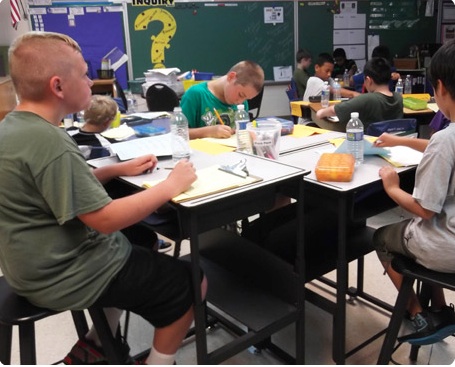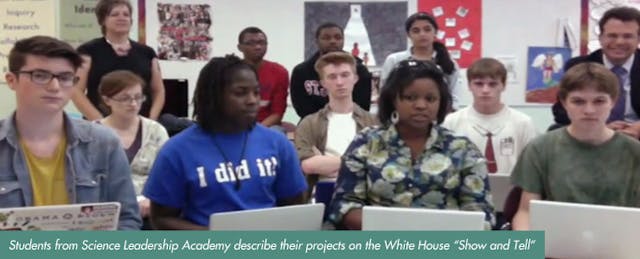It was an amazing end to a genuinely amazing school year.
Just as classes were finishing and students were daydreaming about lazy summer afternoons, President Obama jetted down to Mooresville, N.C., to visit the rock-stars of Mooresville Middle School and announce the ConnectEd initiative, a commitment to getting high-speed bandwidth into just about every school in the country within the next five years. (Last year, although Mooresville ranked in the bottom 10 of North Carolina's 115 school districts in funding per student, it was the second highest achieving district in the state.)
Immediately after the President spoke, the White House invited three other schools to share the highlights of their year via a Google hangout. They were:
- Science Leadership Academy in Philadelphia, PA
- Loris Elementary in Horry County, SC
- Chappell Elementary in Green Bay, WI
And--lucky me--they rang up EdSurge and asked me to moderate the conversation.
You can watch the whole session right here. We didn't have much time to prepare for the hangout. A few minutes before we went live, I told the teachers and students that I'd ask them to describe a couple of their favorite projects. The kids were giggling and whispering; I wondered whether we'd be able to fill the 30 minutes that the White House had allotted for the call.
When the cameras began to roll, however, the students were poised, articulate, funny and frank. Loris students described projects that involved creating a book about what they found at the beach and building Glogster presentations about Civil Rights. Some Chappell students studied problems in the Sudan--and then raised $500 to build a well there. Other Chappell students investigated charges of child labor. And every student at the Science Leadership Academy had a unique and impressive project, from building websites, online portfolios and games, to exploring the science behind local transit using probeware to scripting and filming their own movies and plays.
More tool than gimmick
Students offered thoughtful descriptions of how the technology supported what they were learning. " We don't just do a report and then we're done with it. We do multiple things, we dig deeper and kind of challenge ourselves," said one Chappell fifth grade student.
Particularly in Philadelphia, where the students spend significant time on their computers, they spoke first of the relevance of their projects. "We have five values: inquiry, research, collaboration, presentation and reflection," said a Philadelphia based SLA student. "We use all those core values in everything we do. It's a transient property throughout all our classrooms."
Added an elementary student from Loris: "If… we had to get rid of all the electronic devices--no more iPads, no more computers--they would have to call the emergency room because I'd be passed out on the floor…I feel we need that technology in the classroom… because it just makes the world more interesting."
After the Google hangout, I spoke with the teachers and administrators of these programs to learn a bit more about their schools.
Science Leadership Academy
A magnet high school founded in September 2006 by Principal Chris Lehmann, the Science Leadership Academy is an inquiry-driven, project-based, 1:1 laptop school. It serves about 465 students and is considered one of the pioneers of the School 2.0 movement, both in the US and abroad.
Lehmann relishes all the projects that the SLA students carry out, from using motion sensors and probeware to explore the physics of local transit to designing water pumps with Google sketchup, to writing and filming original screenplays. He emphasized that SLA students largely use the same sets of software tools used in the private sector. "The worst thing is when we create [software products] for our kids that aren't used in the real world," he says. "We do our kids a disservice when we don't give them access to the tools we use in the real world."
"You don't need an educational film making program when you have iMovie. Don't need a junior varsity version of probeware," Lehmann says.
Schools do need some kind of learning management system (LMS) that can be the virtual center of a school community, he adds, supporting communications between teachers, students and parents, as well as storing school records and assignments. SLA has been collaborating with local Philadelphia design firm, Jarvus to create Slate, an LMS that uses open source code and incorporates Google docs.

Project-based learning, Lehmann says, "allows kids entry points where they are. That's incredibly important. If you are ready to accelerate, you can run with it. A kid who needs more basic skills can go at a different pace. A project is done when it is has met everyone's expectation. A student has a sense of completion about it."
During the Google hangout, SLA students demonstrated deep pride in the work they had done over the past year. "A kind of unspoken rule" at SLA, observed one student, is that students wind up spending just as much time working on their projects outside of school as they do during school. "Otherwise they won't be very good," he noted.
The role of technology, said several students, was to support their goals. "We've learned to be self-reliant," said one girl. "The technology can be annoying. Sometimes it just doesn't work." But when students who can't find an expert at the school to help solve a problem learn to seek out tutorials or videos online to solve their problems.
Most crucial, Lehmann says, is building community consensus and a common language of teaching and learning around the value of project-based learning.
Loris Elementary
Loris is a Title I elementary school that serves approximately 780 students in grades pre K through 5. For the past two years, Loris has had a 1:1 program in the fourth and fifth grades involving about 250 students. In September, the school expects to add third grade to the program. The Horry school district, which includes 39,000 students, will start implementing a 1:1 program over the next three years, says Cox, director of online learning at Horry County Schools. And many of those schools will be looking to Loris Elementary along with two other local schools for lessons learned.
This year, Loris students won 10 awards at the local tech fair, including "best" in show. Two years ago, none of its students even entered the fair, says principal Mark Porter.

"We've learned that the easy part is putting the hardware in the hands of the teachers," Porter says. "What's important is not to let it be just a 'replacement' for a textbook or whiteboard. That's been the learning process for us: using the technology to truly go beyond the textbook so that our students learning is more rigorous, engaging and genuine."
About three-quarters of the time, students are using content-related software developed for schools, Porter estimates. Compass Learning is widely used at Loris as is Achieve3000 (for literacy) and Dyknow, classroom management software. But over the next few years, Porter expects the school will begin to use conventional software as it increasingly becomes a project-based learning program.
"It's all about taking small steps and having a good plan," says Edi Cox, director of online learning at Horry County Schools. "We're transforming the role of the teacher in the classroom and making our teachers good leaders."
Chappell Elementary
Chappell Elementary supports approximately 320 students in grades K through fifth. It's one of the first public elementary International Baccalaureate Primary Years Program schools in Wisconsin and it received its IB authorization this past spring.
"We've used a green screen for the kids to do reports from 'historic' locations," says teacher Marie Sauvey, a fifth grade teacher at Chappell. The teachers use a full suite of office tools, from word processing Excel and PowerPoint to Photostory and Audacity. "Easily 90% of our kids will be able to use whatever PC or laptop they encounter," says Sauvey.
Chappell began establishing a one device to one child program four years ago, and at the time created a scope and sequence of the skills appropriate for each grade. "Our kids have really developed those skills; now it's time we increased the rigor of that scope and sequence," says Principal Kris Worden.

It takes schools several years to meet the standards and qualify as an IB school. Such programs already incorporate a scope and sequence much like the Common Core, notes Sauvey. "I like the Common Core," she adds, in part because it helps teachers synch up their curriculum plans, an advantage when students switch schools.
Having an entire staff committed to delivering a consistent scope and sequence of curriculum helped Chappell implement both its IB curriculum and technology. "Everyone took responsibility for being an expert in some area," says Worden. "At first we had people who struggled to use a DVD. But everyone helped each other grow. They became each other's mentors."
Sauvey says that every two months, Chappell's teachers put on an in-house "show and tell" session to give teachers a chance to share how they were implementing technology. "And you had people who said, 'Oooh, I didn't think of using it that way,'" she recalls.
Technology isn't typically used for remediation. "We feel the best remediation is a teacher." But technology does enable students who are excelling a chance to rocket ahead, she adds.
"We're seeing the fruits of all the hard work that we've put into tech integration and establishing the IB program now," says Worden. "Kids are owning their learning. Even in kindergarten, they're not saying, 'So what?' They're taking action and understanding they have a role in this world. When we can trust in ourselves to release to the kids, the learning and power will come in."


